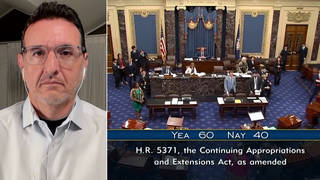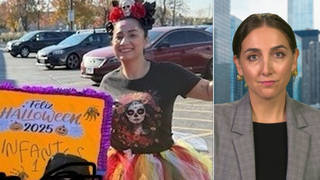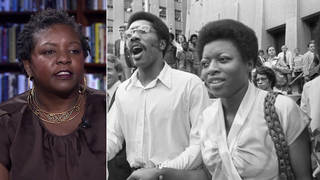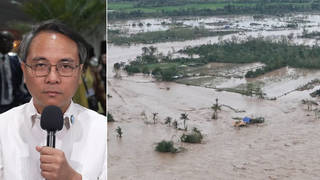
Topics
Guests
- Miaija Jawarahigh school senior in Harlem. She is a member of the Urban Youth Collaborative as well as the Dignity in Schools Campaign-NY Chapter. Earlier this month, she participated in the White House Initiative for African-American Excellence in Education.
- Kesi Fostercoordinator of the Urban Youth Collaborative.
- Phil Stinsoncriminologist and associate professor at Bowling Green State University.
- Jaeah Leereporter for Mother Jones magazine. Earlier this year, she wrote an article called “Chokeholds, Brain Injuries, Beatings: When School Cops Go Bad.”
New York City has more than 5,000 police officers patrolling the city’s schools—that’s more than the combined number of school guidance counselors and social workers. Nationwide, more than 17,000 officers work in the school. What happens when students are arrested in the classroom? We look at what many experts call the “school-to-prison pipeline.”
Transcript
JUAN GONZÁLEZ: Well, I want to bring in two more guests. Miaija Jawara is a high school senior in Harlem. She’s a member of the Urban Youth Collaborative as well as the Dignity in Schools Campaign-New York Chapter. Earlier this month, she participated in the White House Initiative for African-American Excellence in Education. And Kesi Foster is a coordinator of the Urban Youth Collective.
Miaija, talk about your experiences with school safety officers, as they’re called here in New York City.
MIAIJA JAWARA: So, in my school, we have—since freshman year and—since my freshman year until my senior year, there’s been an increase in the number of school safety agents in my school so far. And with the increase of school safety agents, we don’t have metal detectors in our school, but we have roaming metal detectors. So, since the increase of school safety officers, the amount of times where we have the pop-up metal detectors come in our school, that’s increased, as well. The way that the school—the way that the children were disciplined, it seemed much more harsher since the increase. My experience alone, I’ve dealt with a lot of—like things that are really normal, like maybe I’m a few minutes late to class, ends with me, instead of being sent to class, being sent to the safe room, which is basically a detention room. And we—I’ve been held there like for an entire class period for being like maybe just a couple minutes late to class. So, that’s been my experience.
JUAN GONZÁLEZ: And in the detention room, you have a safety—
MIAIJA JAWARA: Yeah, well, the safe room, yeah.
JUAN GONZÁLEZ: The safe room, you have safety officers, as well?
MIAIJA JAWARA: Yeah, there’s two on—outside the entrance to the room.
AMY GOODMAN: So, if you could talk about your own experience—you got in a fight outside school?
MIAIJA JAWARA: Mm-hmm. So, it was in February of this year, just, you know, petty high school drama. Every high school has it. We were on school property, and we had fought after school. And we were right—we were still on school property, so, essentially, the school safety agents were the ones that were supposed to deal with the fight. But since it was kind of outside, even though we were still on school property, NYPD ended up dealing with the case. So, in addition to getting—well, being threatened with a suspension, after the fight was over, the two of us were pulled apart, put on opposite sides of the cop car, threatened with an arrest and given a criminal summons, and I had to appear in court in April of this year.
AMY GOODMAN: And what happened?
MIAIJA JAWARA: When I went there, they said the case was dismissed. But when I went to school, I still had to deal with—they threatened me with a suspension, but I offered, “How about peer mediation instead?” So…
JUAN GONZÁLEZ: And, Kesi Foster, in her case, apparently, the police, other than giving her a summons, didn’t appear to do—exercise any violence. What’s wrong with that situation?
KESI FOSTER: For receiving a summons?
JUAN GONZÁLEZ: Yes.
KESI FOSTER: So, here we have an incident which happens in high schools all across the country. Right? There was a very small, minor altercation between two students. And instead of it being dealt with by school authorities, Miaija is now being introduced into the criminal justice system for the first time in her life, right? Students that go to court during school days, because if you get a criminal summons during—you have to go to court during a school day, are four times more likely to drop out of high school than students that do not. In New York, right, because you are—at 16 years old, you are charged as an adult for anything, if you are charged with a criminal summons in a school and you don’t appear in court, or if there’s a fine that’s attached to that and you don’t appear, we now have high school students that are having open bench warrants for things that are happening within our schools, that traditionally we have handled within the schools. But over a period of time, we have now criminalized the behavior of black children, that is treated differently in other districts.
AMY GOODMAN: In New York, who’s in charge of these, what are called security officers, or SROs, in other places?
KESI FOSTER: So, in New York, they are referred to as school safety agents. They are part of the NYPD. They are not under the purview of the Department of Education. They are under the purview of the New York Police Department.
AMY GOODMAN: How much money is spent on them? Who do they answer to?
KESI FOSTER: So the money for police in schools is actually spent by the Department of Education. It’s somewhere between $360 million and $400 million a year, annually, for what they are calling school safety needs.
JUAN GONZÁLEZ: And I’ve spoken to principals in New York City schools who complain about the fact that they have no control over these safety agents. If there’s a particular one that they don’t like their methods, they have no control over whether they stay in their school or not. And as you say, they basically are the arm of the police department inside the public schools.
KESI FOSTER: There was an incident last year at a high school in Brooklyn in which a young man was walking through a school—a metal detector he had in his school. He had broken glasses, and so he had a safety pin that was holding his glasses together. And he was told, “You can’t come in with that, because it’s a weapon, or you can use it as a weapon.” And he said, “I’ve been coming to school with my broken glasses for weeks, and no one’s ever bothered me.” And so the safety agents told him, “If you come in, right, we’re going to confiscate your glasses. So leave them out here.” And he said, “I can’t go to school all day without my glasses.” And so, that turned into an altercation in which he was tackled in front of all of his classmates for trying to go into school with a pair of broken glasses.
After being tackled and given a summons, he thought the incident was over, but someone from the school actually ended up calling in the local police. And so now the local police department came and said there’s an incident at the school, and they held that child in a room with no adult supervision or anyone involved for a number of—I don’t member how long it was, about an hour or so. And the principal at that school at that time, right, something that she could have handled very easily, knowing the student and knowing this is not a dangerous situation, couldn’t control what happened throughout that whole incident.
AMY GOODMAN: I wanted to go to another story. Earlier this year in Kentucky, a deputy sheriff handcuffed two elementary school children with disabilities. This is according to a lawsuit filed by the American Civil Liberties Union. The eight- and nine-year-old kids were so small that the deputy sheriff, who was working as the school’s resource officer, cuffed their biceps, because the handcuffs didn’t fit their wrists. One of the children is black, the other is Latino. Jaeah Lee, in your research, can you talk about how this fits into what’s happening across the country and the response?
JAEAH LEE: Sure. That question goes back to the history of the rise of school resource officers on K-through-12 campuses. The first sort of documented instances in which we saw cops enter school grounds was somewhere in the 1950s. The exact time is unclear. But it wasn’t until the early 2000s that we really started to see a huge spike, and that was, of course, after the tragic mass shooting at Columbine High School. The Department of Justice, since then, has spent close to a billion dollars in grants to hire school cops. It sounds like there have also been grants coming from the Department of Education. And many more school districts have spent their own budget funding to hire school resource officers. In the wake of Sandy Hook, according to the National Association of School Resource Officers, we’ve seen another spike. And, of course, what we’re seeing now, from what I hear from talking to various sources, is that there’s a larger growth happening on elementary school campuses. And so, I think in the years ahead we’ll see more incidents happen with younger children, like we did in Kentucky.
JUAN GONZÁLEZ: And, Phil Stinson, in about a minute, could you tell us to what degree the—to what degree the police are being deployed in minority school districts, largely, as opposed to white school districts across the country?
PHIL STINSON: Well, I think they’re deployed similarly across the country. There’s very little in the way of data that would be able to break that down, that I’m aware of, so it’s kind of difficult to tell. But they’re used in different ways in the schools in which they are placed. And I think it is apparent that there’s—you know, some race issues are involved here. And that’s something that needs to be looked at. My biggest concern here is, you know, the school-to-prison pipeline, where we’ve got academic failure, we’ve got exclusionary disciplinary practices, and we’ve got kids dropping out of high school. And the other thing that I’ve seen in my research is that girls that are brought into the juvenile justice system have a history of trauma. And we look at the video from South Carolina—certainly, that was a traumatic experience that girl encountered.
AMY GOODMAN: I think it’s very interesting that yesterday in all the news coverage that I saw, they kept repeating that the girl was not hurt. Now, who did they get this from? I didn’t see them speaking to the girl, so who did they get this from? Miaija, when you saw this video, did it shock you? Have you seen anything like this in your own school in Harlem?
MIAIJA JAWARA: It definitely did shock me, because just the way that the situation—how fast it escalated. It went from her sitting in her desk, the desk being flipped over, to her being dragged across the room. It definitely did shock me. And while I haven’t seen in my own—I haven’t seen it myself, I haven’t seen something as serious as that, I have seen students being pulled—being aggressively pulled out of the classroom because they don’t want to leave the classroom. Wow. It’s just that this is similar, just like I feel like I’m watching the McKinney pool party all over again. It’s a girl who is obviously much smaller than the person who is attacking her.
AMY GOODMAN: Wait just one sec. You talk about the McKinney pool party. We have video of that. And for radio listeners, they can go to our website. But let’s go back to that, because me, too, when I saw this, I thought this is exactly the same approach. Talk about what happened with this white officer and this—I think she was 14 years old—
MIAIJA JAWARA: Yeah, she was 14 years old.
AMY GOODMAN: —girl in her bikini.
MIAIJA JAWARA: Mm-hmm. So, it was a neighborhood pool party. Someone had invited people from—I’m assuming from school or from just in their community, invited them to the pool party. They were all invited guests, everyone that was there. And other people who lived in that neighborhood, they were complaining, saying, “Oh, we don’t want these black people in our neighborhood. Go back to your Section 8 housing.” And the police were called. And in the video, as you can see, as soon as the police were called, everything was completely out of control. The 14-year-old girl, she’s viciously slammed to the floor. Her head is put—her face is in the grass. And she’s being—the officer is kneeling into her back. In the video, you can hear her saying, “Get off me.” She’s obviously in distress. And when I see the video from South Carolina, I think of the same thing that happened in McKinney. This is another girl, another girl who’s about—much smaller than who’s attacking her. And it’s, at this point, is why do we—why is this happening again? Why is it repeating?
JUAN GONZÁLEZ: And, Kesi Foster, what do you think needs to be done? What is your organization advocating for in terms of the use of these safety agents in schools?
KESI FOSTER: Sure. So, I would say the young people, the high school students, the organizers from our organization, black and Latino organizers in New York City, as well as black and Latino organizers, high school students, throughout the country, and even parents, through the Dignity in Schools Campaign, are organizing to—one, we are organizing to eliminate suspension policies that are deeply rooted in anti-racism and—anti-blackness and racism. Right? And so, it is only—right? The biggest indicator for a student being suspended for these minor infractions is that they are black. When you control for every other factor, socioeconomic and every other factor that they say leads to so-called misbehavior, the research clearly shows that the biggest indicator for a student being more likely to be suspended is that they are black.
And so we are advocating for an elimination of suspension and policies that push students out of school. Right? And we are also advocating for replacing school resource officers and police officers in schools with more guidance counselors, social workers, community intervention workers, and professionals that are trained in trauma-informed practices to create a safe and supportive system for schools and for young people. New York City has 5,400 school safety agents and a combined 3,600 guidance counselors and social workers. And so, we are not investing in the future of black children. We’re not investing in public education. We’re investing in prison cultivation.
AMY GOODMAN: So you want the ratio flipped?
KESI FOSTER: We want the ratio flipped on its head, yes.
AMY GOODMAN: We’re going to leave it there, but we’ll continue with this issue. Miaija Jawara, I want to thank you for being with us, and Kesi Foster, both with the Urban Youth Collaborative. Miaija Jawara is a student, a senior at a Harlem high school here in New York. Phil Stinson, speaking to us, a criminologist from Bowling Green University in Ohio, Bowling Green State University. Jaeah Lee, a Mother Jones reporter, we’ll link to your piece at Mother Jones. And Adam Loewy, speaking to us from Austin, the attorney who represented Noe Niño de Rivera. We thank you all for being with us.
When we come back, we’re going to talk about a change of heart, an evangelical minister, when it comes to gun rights and gun violence, and the woman who changed him, the story of her 17-year-old son, a story you’ve come to know well here on Democracy Now! Stay with us.
WATCH NEXT
Cops in the Classroom: South Carolina Incident Highlights Growing Police Presence in Schools
Texas Student Spent 52 Days in Coma After Being Tased by Police at School











Media Options